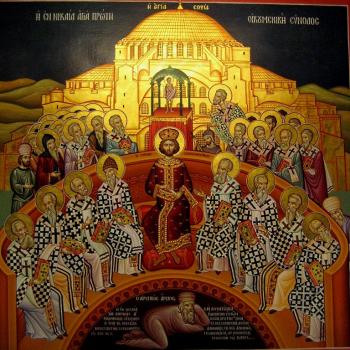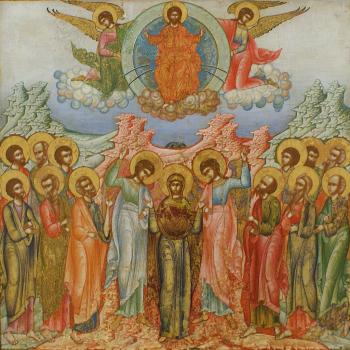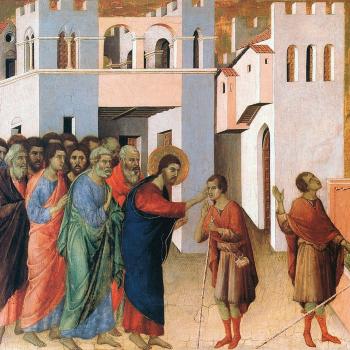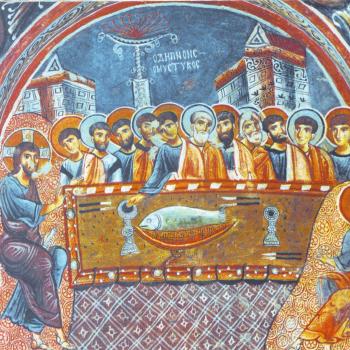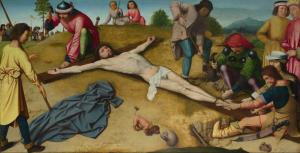 While we should not limit femininity so that we only think of child birth as being the only thing which makes women unique, for there are many women who never give birth for one reason or another and yet represent the special charism given to all women, nonetheless whenever we find the use of child-birthing metaphors in the spiritual tradition, it is clear we are dealing with the special feminine charism.[1] Of course, “masculinity” and “femininity” are often conventions established in cultural situations, reducing men and women to particular aspects of the human condition, and it often becomes difficult for us to separate what truly is a feminine or masculine charism, and what is a social convention which over essentializes the two conventions. This is how and why so many cultures recognize what is seen as masculine and what is seen as feminine is to be found in all, but in doing this, it still is easy to absolutize the convention and try to make women conform to so-called “feminine” principles and men to so-called “masculine” ones. This, of course, reduces persons to constructs and does not allow them to engage the fullness of who and what they are. They are more than their gender, though of course, it has a real effect on who and what they are. They are more than their gender, and indeed, they share in and experience elements of the other-gender, while also finding themselves transcending all such distinctions, not through a gnostic denial of gender, but by its proper realization which is experiential and not just ideological. In other words, while there is something real about gender, what it is cannot be so easily established in and through concepts or words, which is why so many fall for the easy thing to do which is to examine gender as a result of bodily functions.
While we should not limit femininity so that we only think of child birth as being the only thing which makes women unique, for there are many women who never give birth for one reason or another and yet represent the special charism given to all women, nonetheless whenever we find the use of child-birthing metaphors in the spiritual tradition, it is clear we are dealing with the special feminine charism.[1] Of course, “masculinity” and “femininity” are often conventions established in cultural situations, reducing men and women to particular aspects of the human condition, and it often becomes difficult for us to separate what truly is a feminine or masculine charism, and what is a social convention which over essentializes the two conventions. This is how and why so many cultures recognize what is seen as masculine and what is seen as feminine is to be found in all, but in doing this, it still is easy to absolutize the convention and try to make women conform to so-called “feminine” principles and men to so-called “masculine” ones. This, of course, reduces persons to constructs and does not allow them to engage the fullness of who and what they are. They are more than their gender, though of course, it has a real effect on who and what they are. They are more than their gender, and indeed, they share in and experience elements of the other-gender, while also finding themselves transcending all such distinctions, not through a gnostic denial of gender, but by its proper realization which is experiential and not just ideological. In other words, while there is something real about gender, what it is cannot be so easily established in and through concepts or words, which is why so many fall for the easy thing to do which is to examine gender as a result of bodily functions.
This is not to say we cannot learn from and engage the special actions which women and men can do, and with it, realize that giving birth is truly a feminine quality. It is in this way that we can begin to see how and why Jesus is able to share in and participate in femininity, to make sure that in him there is no division between male and female because he represents and engages them both in his humanity. Christ, many great mystical saints indicate, gave birth to the church. Physically, he might have come as man, but he himself transcends genders and engages the labor pains which women face with his own labor pains, pains which St. John of Avila saw Jesus experience in and throughout his life. Christ on the cross is not just like any birth-mother, but one who gives her all for the sake of her beloved child because Christ can be seen as dying in the labor itself:
If you suffered this on the cross, with your hands and feet nailed, a thin that exceeds all the love of mothers, who will tell of the great love and pain with which you bore all men in the womb of your heart, groaning over their sins with the groans of childbirth? You did this not for an hour or a day but for the whole thirty-three years of your life until, like another Rachel, you did in childbirth on the cross so that Benjamin might be born alive (Cf. Gen 35:18). The “serpents” you were carrying within you, Lord, were giving you such bites that they caused you to burst open on the cross. This was so that, at the cost of your pains, the “serpents” would be transformed into simple and meek sheep who, in exchange for your death, would attain a life of grace.[2]
We are heirs to the kingdom of God because Jesus has given birth to us. While he came in the form of a man, he acts as a woman, as a birthmother; he transcends masculinity and femininity as he take both upon himself and embraces both in his incarnation. There is neither male nor female and yet there is no extinction of the sexes, either; there is no separation and division which makes one or another superior, but there is also no rejection of their distinctions and greatness and qualities. We become one with him and in him, so that, in and through that unity, we find ourselves sharing in experiencing the transcendental relationship with genders within ourselves. Thus, in what may seem paradoxical, after Jesus gives birth to us, we are to give birth to Jesus in ourselves. We are born into the kingdom of God, we are given a second birth through Jesus, and now we give birth to Jesus in ourselves. Meister Eckhart, reflecting upon this, said, “God acts like that: He gives birth to his Only-begotten Son in the highest part of the soul. And as he gives birth to his Only-Begotten Son into me, so I give him birth again into the Father.”[3]
We must not look at this materialistically, limited to positivistic notions of time and space. We must look deeper to understand this paradox, where Christ gives birth to as we give birth to Christ. We do it together. We share in the labor paints together. He is the eternal Son of God who is eternally begotten of the Father before all ages; he was born of the Virgin Mary and became man. In the hypostatic union, he came to his creation full of love, full of self-giving sacrifice. Jesus came to his own which knew him not, to guide and shepherd them, but also to take care of them as a mother-hen looks after her own:
You called yourself a mother when, speaking with Jerusalem, you said: “How many times I wanted to place your children under my wings, like the hen, and you did not want it” (Matt 22:37). To make us understand the personal love and tenderness of your heart, you compared yourself with the hen that especially loses her calm and is stricken by what touches her children.[4]
Christ, so full of compassion, so full of sorrow and grief for what was done to his children, spoke out and preached on their behalf. The Sermon of the Mount gives us his blessing to his children but also his warning to those who would take advantage and harm his little ones. It is with such motherly attention he also said:
Whoever receives one such child in my name receives me; but whoever causes one of these little ones who believe in me to sin, it would be better for him to have a great millstone fastened round his neck and to be drowned in the depth of the sea (Matt. 15:5-6 RSV).
We, too, in giving birth to Jesus, must feel the same; all who would wipe out and destroy the good in the world in order to squash this spiritual birth, all the would-be Herods who would denounce social justice and mercy to destroy the birth of Christ in those who follow him, must be warned of the millstone they are fastening upon themselves. Woe to those who follow after the glories of the world, woe to the rich and powerful, because so long as they hold on to such idols of earthly glory they will be unable to give birth to Christ. The seed which was sown in them can be strangled by the embrace of injustice, which is why we must be cautious and protect that birth from all which would squash it, from the legalistic extortions of the vainglorious to the avaricious greed which seeks to take the very food and drink of Christ away from him.
We find ourselves tied and joined in together with the labor pains of Christ. He gives birth to us, and then we in turn give birth to him, as one interdependent birthing process accomplished throughout our lives. We live in the world, born anew in Christ, only to labor for Christ and to give birth to him anew. But we, moreover, must also become midwives, so that not only do we give birth to Christ in ourselves, we help Christ give birth to others, other children, who then likewise give birth to Christ. It is a marvel, a mystery, a paradox, a spiritual truth which can not be understood without a spiritual vision, and that vision can only come if we let ourselves be born again in Christ as we let Christ be born again in us.
[Image=Christ nailed to the cross by Gerard David [Public domain], via Wikimedia Commons]
[1] Clearly, we should not judge a woman by how many children they do or do not have, and to do so, is to do a grace injustice to her.
[2] St. John of Avila, Audi, filia: Listen, O Daughter. Trans. Joan Frances Gormley (New York: Paulist Press, 2006), 233.
[3] Meister Eckhart, “Sermon 22: Ave, gratia plena” in Meister Eckhart: The Essential Sermons, Commentaries, Treatises and Defense. Trans. and intr. Edmund College, OSA and Bernard McGinn (New York: Paulist Press, 1981), 194-5.
[4] St. John of Avila, Audi, filia: Listen, O Daughter. 232.
Stay in touch! Like A Little Bit of Nothing on Facebook




